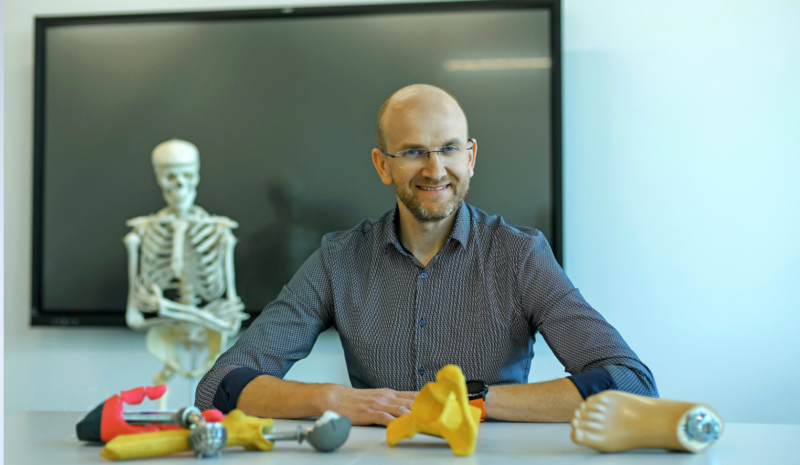Home
For international students
VILNIUS TECH scientists on paralympic prosthetics: can they give an advantage over athletes without disabilities?
- Programmes in English 2026/2027
- Admission 2026/2027 Scholarships
- For exchange students
- Free Movers
- Transfer studies
- Erasmus+ studies and traineeships
- Mentor programme
- Student testimonials
- Accommodation
- Career Services
- Medical Care
- Immigration Regulations
- Leisure and Student Activities
- Useful information
- Mental and spiritual support
- Representatives Abroad
- Contacts
.png)
2024-09-13
VILNIUS TECH scientists on paralympic prosthetics: can they give an advantage over athletes without disabilities?
The Paris Paralympic Games captivated audiences worldwide, showcasing the impressive abilities and results of athletes with disabilities. Some paralympians use prosthetics that not only compensate for lost functions but may even offer advantages in certain sports. "Scientists debate that, in certain situations, prosthetics could provide an advantage over athletes without disabilities," says Professor Dr. Julius Griskevicius, head of the Department of biomechanical engineering at VILNIUS TECH Faculty of mechanics.
"Running blades" imitate the characteristics of biological limbs
According to Prof. Dr. Julius Griskevicius from Vilnius Gediminas Technical University (VILNIUS TECH), sports prosthetics are significantly different from conventional ones. They are designed with a specific shape that aids in certain movements, such as jumping, running, or engaging in other physical activities requiring flexibility as well as durability.
Sports prosthetics are often made from carbon fibre, which efficiently absorbs and returns energy. They are not only energy-efficient but also lightweight, strong, and dynamic. The type of prosthetics used by professional athletes varies depending on the sport.
"For example, runners need lightweight and highly elastic prosthetics, while cyclists and swimmers may use prosthetics optimised for aerodynamics or buoyancy. Athletes in track and field events typically use carbon fibre prosthetics known as 'running blades.' These prosthetics are designed to maximise speed and dynamism," explains Prof. Dr. Griskevicius.
"Running blades," like those used by notable athletes such as German long jumper Markus Rehm and South African sprinter Oscar Pistorius, store and release energy during running, mimicking some of the properties of biological limbs.
"Carbon fibre blades function similarly to calf muscles and Achilles tendons – when a runner compresses the structure, energy is stored, and when released, it is freed," the professor explains.
Prof. Dr. Griskevicius adds that the key difference between biological limbs and prosthetics is that carbon fibre prosthetics lack functional feet. This is significant, as biological feet, through the ankle joint, have an additional axis of rotation that contributes to energy production and plays a critical role in running biomechanics.
"The muscles in the foot help push off the ground, increasing metabolic efficiency – with each step, the body doesn’t need to use as much energy because the muscles do part of the work. In contrast, a prosthetic blade lacks this active foot rotation and doesn’t generate energy on its own. The energy return from the blade comes only from its structure and materials. The runner must compensate for the lack of foot muscle activity using other muscles, such as the thighs and hips," says the head of the Department of biomechanical engineering at VILNIUS TECH.
Can prosthetics provide an advantage over athletes without disabilities?
Some scientists argue that carbon fibre prosthetics have features that, in certain situations, may offer an advantage over athletes without disabilities. Firstly, these prosthetics return energy more efficiently than natural muscles, allowing athletes to generate more force. Additionally, they can be designed to meet specific mechanical needs, such as minimising weight or increasing the range of motion.
"Track and field, especially sprinting, is one area where prosthetics might provide an advantage, as they can generate more energy during certain phases of running, such as when the runner accelerates to maximum speed – they can move the prosthetics faster with less effort.
Prosthetics may also provide an additional spring-like effect in jumping events. Scientists have found that Markus Rehm and other world-class long jumpers with below-knee amputations use a different jumping technique than athletes without prosthetics. While the elastic plates of the prosthetics might limit the jumper’s maximum speed, they allow for a better take-off technique. However, scientists still cannot definitively answer whether Rehm’s prosthetic gives him an overall advantage. Researchers continue to debate the pros and cons of prosthetics in relation to running performance," says the scientist.
Prof. Dr. Julius Griskevicius’ insights are supported by the ideas of Associate Professor Dr. Jurgita Ziziene from the Department of biomechanical engineering at VILNIUS TECH, who notes that evaluating the impact of prosthetics on athletic performance is extremely difficult.
"This depends heavily on many factors: the level of amputation, the causes of amputation, the number of amputated limbs (one or both), the shape of the stump, or the individual's physical characteristics. Since it's impossible to gather a uniform sample for research, it’s not feasible to conduct accurate experimental studies that would conclusively answer this question," says Dr. Jurgita Ziziene.
Nevertheless, scientists are working to use the most innovative methods to conduct as accurate assessments of prosthetics' impact on sports performance as possible.
"One approach is digital modelling, which I believe is well-suited for evaluating the impact of the prosthetic's design or the materials used. Muscle-skeletal models allow for more parameters to be identified, but creating and adapting them for each athlete individually is quite a challenge. If the lower limb is amputated above the knee, significant attention must be paid to the knee joint. Currently, there are microprocessor-controlled knee joints that function using various motion pattern algorithms or artificial intelligence," explains Dr. Jurgita Ziziene.
Prof. Dr. Julius Griskevicius adds that the advancement of technology will likely lead to even smarter prosthetics, which will better adapt to the athlete’s needs. According to him, artificial intelligence, advanced materials, and biomechanical research could lead to the prosthetics that not only compensate for lost functionality but also adapt in real time to varying loads.













